
Eriophyllum lanatum, with the common names common woolly sunflower and Oregon sunshine, is a common, widespread, North American plant in the sunflower family.
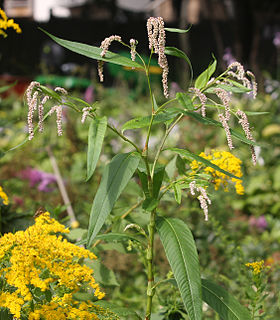
Persicaria lapathifolia, known as pale persicaria, is a plant of the family Polygonaceae. It is closely related to Persicaria maculosa and as such is considered a weed in Britain and Europe. Other common names for the plant include pale smartweed, curlytop knotweed, and willow weed. It is a species complex made up of a great many varying forms, sometimes considered varieties. The environment also has a strong influence on the morphology of an individual plant.
Erigeron breweri is a North American species of flowering plants in the daisy family known by the common name Brewer's fleabane.
Eucephalus breweri is a North American species in the aster family known by the common name Brewer's aster. It is native to California where it grows primarily in the Sierra Nevada at subalpine elevations. Its range extends into northwestern Nevada and southwestern Oregon.

Fallopia baldschuanica is an Asian species of flowering plant in the knotweed family known by several common names, including Russian-vine, Bukhara fleeceflower, Chinese fleecevine, mile-a-minute and silver lace vine. It is native to Asia, and it can be found growing wild in parts of Europe and North and Central America as an introduced species.
Polygonum bidwelliae is an uncommon species of flowering plant in the knotweed family known by the common name Bidwell's knotweed. The plant was named for American suffragist Annie Bidwell, who at one time lived in the Bidwell Mansion in Chico, California. She is the person who collected the type specimen in Northern California.
Polygonum bolanderi is an uncommon California species of flowering plant in the buckwheat family known by the common name Bolander's knotweed.
Polygonum californicum is a species of flowering plant in the buckwheat family known by the common name California knotweed. It is native to the west coast of the United States from Washington, Oregon, and northern and central California in the Coast Ranges and Sierra Nevada foothills as far south as Napa and Tulare Counties. It can be found in many types of open habitats.
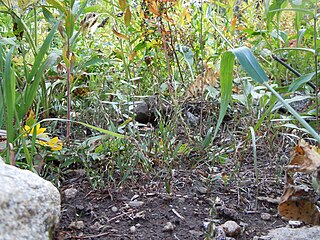
Polygonum douglasii is a species of flowering plant in the knotweed family known by the common name Douglas's knotweed. It is native to much of northern and western North America, where it can be found in many types of habitat, including disturbed areas. It has been found in Canada from British Columbia north to Yukon and east as far as Québec, and in the United States as far south as California, New Mexico, Iowa, and New York.
Polygonum marinense is a rare North American species of flowering plants in the buckwheat family known by the common name Marin knotweed. It is endemic to California, where it is known from just a few locations north and east of San Francisco Bay.
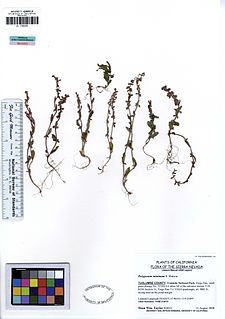
Polygonum minimum is a species of flowering plant in the knotweed family known by the common name broadleaf knotweed. It is native to much of western North America where it can be found in mountainous regions. It grows in the subalpine and alpine climates of high mountain ranges from Alaska to Arizona and New Mexico.
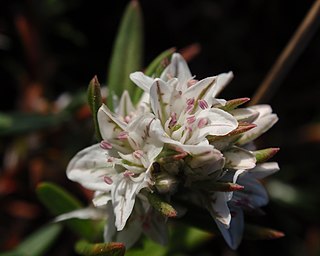
Polygonum paronychia is a species of flowering plant in the knotweed family known by the common names dune knotweed, black knotweed, and beach knotweed. It is native to the coastline of western North America from British Columbia to California, where it grows in sandy coastal habitat such as beaches, dunes, and scrub.
Polygonum parryi is a species of flowering plant in the knotweed family known by the common names Parry's knotweed and prickly knotweed. It is native to the western United States from Washington to California, where it grows in several types of moist, open habitat in mountainous and coastal areas.

Polygonum polygaloides is a North American species of flowering plants in the buckwheat family known by the common names milkwort knotweed and polygala knotweed. It is native to much of western North America, where it can be found in many types of moist habitat. It is a variable species, usually divided into a number of subspecies.
Polygonum hickmanii is a rare species of flowering plant in the buckwheat family known by the common names Scotts Valley polygonum and Hickman's knotweed. It is endemic to Santa Cruz County, California, where it is known from only two sites in the Scotts Valley. It grows on coastal prairie on mudstone and sandstone substrates, in an area known for its spring wildflowers. The small plant was first noted in 1990 and described as a new species in 1995. The plant is a federally listed endangered species.
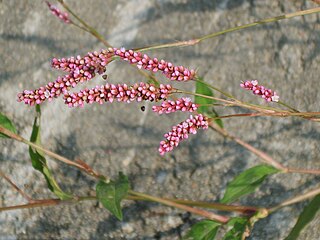
Persicaria longiseta is a species of flowering plant in the knotweed family known by the common names Oriental lady's thumb, bristly lady's thumb, Asiatic smartweed, long-bristled smartweed, low smartweed, Asiatic waterpepper, bristled knotweed, bunchy knotweed, and tufted knotweed. It is native to Asia, and it is present in North America and Europe as an introduced species and often a weed.
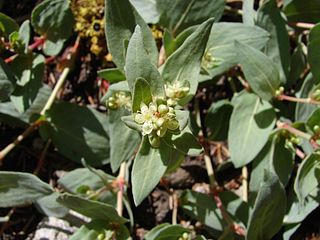
Koenigia davisiae is a flowering plant in the knotweed family that is known by the common names Davis' knotweed or Newberry knotweed.

Koenigia phytolaccifolia is a species of flowering plant in the knotweed family, known by the common name poke knotweed.

Koenigia polystachya is a species of flowering plant in the knotweed family, known by the common names Himalayan knotweed and cultivated knotweed. It has several regularly used synonyms, including Polygonum polystachyum, Aconogonon polystachyum and Persicaria wallichii.
Polygonum majus is a North American species of flowering plant in the buckwheat family known by the common name wiry knotweed. It grows in the western United States and western Canada, from British Columbia south as far as the Sierra Nevada of northwestern Inyo County in California, east as far as Montana.














